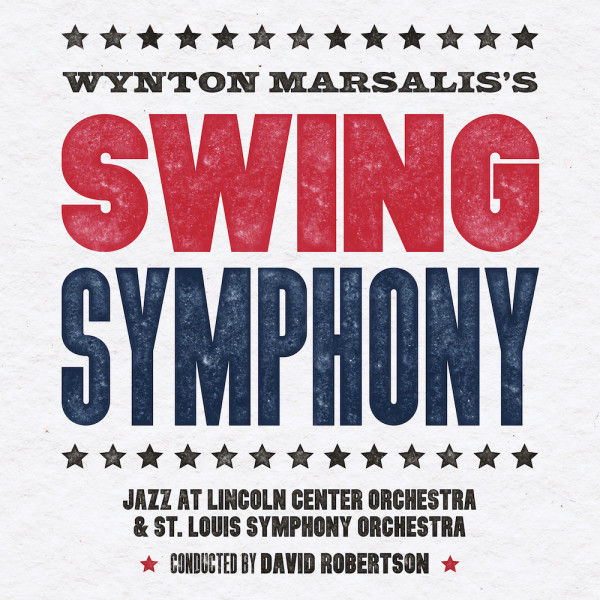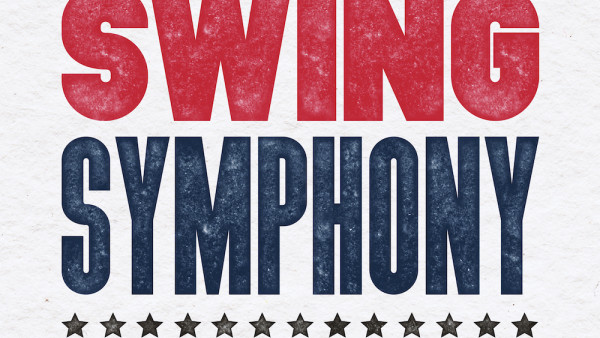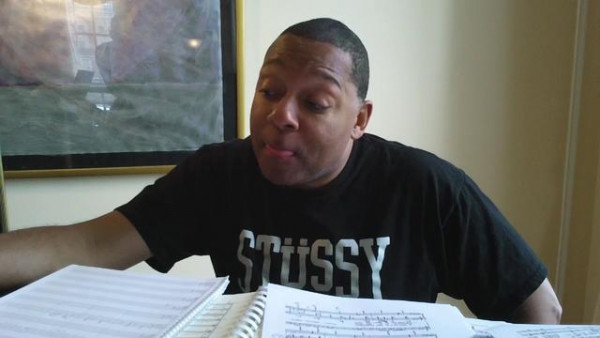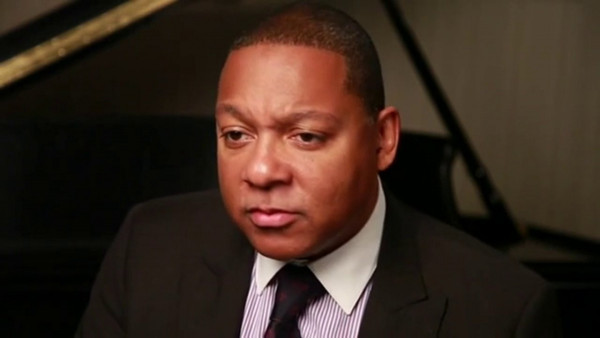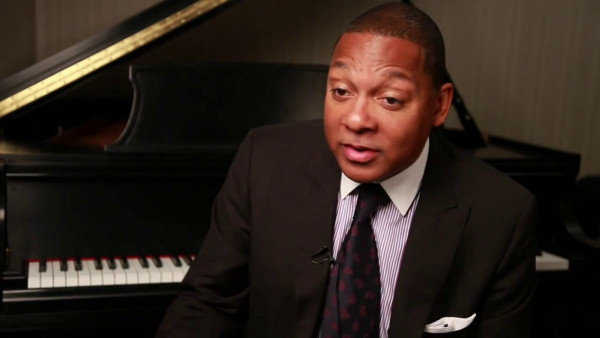Wynton Marsalis swings for the fences
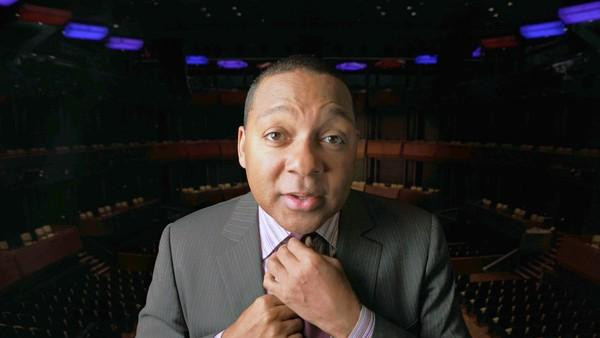
(photo: Carolyn Cole / Los Angeles Times)
Reporting from New York — Wynton Marsalis is explaining jazz to me by talking about my boots. He is coming to Walt Disney Concert Hall this weekend to play his ambitious new composition, “Swing Symphony,” with the Los Angeles Philharmonic. But before we get into musical details, he says, “I want you to understand the concept of swing.”
“It’s all about fundamentals,” he says. “And what is a fundamental? A fundamental is me and you. We’re two different people. I don’t have any idea where you’re from. Maybe you know I’m from New Orleans. I could look at your glasses, the color of your hair, your shirt, the way you’re dressed — you have on boots — and deduce who you are. It would all be wrong.”
The trumpet player, of course, is as famous for his sermons on jazz as for the pellucid tones of his horn. The subtitle of one of his books is: “How jazz can change your life.” But on this afternoon, the 49-year-old musician, casually dressed in khakis and a pullover sweater, is all charm and enthusiasm.
Sitting on the edge of a couch in his dressing room at Jazz at Lincoln Center, the performing arts organization of which he is artistic director, shadowed by photographs of Dizzy Gillespie and Miles Davis, Marsalis continues his verbal run.
Now, imagine this wasn’t an interview, “which is an unnatural situation,” he says, “and we just met on a plane and started talking. Man, we’d have so much in common. I got to figure out when I’m going to be quiet and when I’m going to ask you something. You have to figure out what you’re going to pick up on. We’re swinging! So the ultimate swing is when opposite poles comes together and are forced into a dance with each other.”
“I think I’ve got it,” I say, eliciting a smile from him. He then proceeds to launch into a five-minute dissertation on the rhythm of swing, punctuating his nouns and verbs with hand claps, foot taps and onomatopoeic sounds. Should he ever tire of the trumpet, Marsalis clearly has a future as a human one-man band.
Combining two seemingly opposite musical poles — classical music and jazz — into a swinging whole is what inspired Marsalis to put pen to stave. In six multivalent movements, “Swing Symphony” traces the quintessentially American journey of jazz from New Orleans ragtime to Kansas City swing to New York bebop.
For two performances at Disney Hall, Marsalis and his 15-piece big-band ensemble, Jazz at Lincoln Center Orchestra, will be flanked by the L.A. Phil, conducted by Leonard Slatkin, music director of the Detroit Symphony Orchestra, a passionate advocate of new music and well known to local audiences for his many Southern California appearances.
Born into a jazz family, Marsalis also grew up with Beethoven on his mind. He earned bravos at age 16 for playing the Haydn Trumpet Concerto, studied classical music at Juilliard and in 1983 won a Grammy for an album of trumpet pieces by classical composers, including Mozart. (He also won a jazz Grammy that year.)
Since then, along with his 50 or so jazz albums, which have sold around 7 million copies, he’s recorded nine classical albums that range across the canon; his 1997 oratorio, “Blood on the Fields,” won the Pulitzer Prize. “Swing Symphony” is his third venture into classical music’s big-time form, following “All Rise,” a 12-part symphony recorded with the L.A. Phil in 1997, and the six-part “Blues Symphony,” premiered at the Atlanta Symphony Orchestra in 2009.
Orchestrating major productions describes Marsalis’ role at Jazz at Lincoln Center. The nonprofit enterprise, housed in the Time Warner Center and a few blocks from Marsalis’ apartment, hosts two clubs and the Frederick P. Rose Hall, an exquisite space that has graced the world’s best jazz artists. For the past 23 years, the jazz czar has been on a mission to enlighten kindergarten kids to college students through the center’s programs. Like “America’s music” itself, he says, the center is about “relationships, communications and negotiations.”
On their way to perform with the L.A. Phil, Marsalis and the Jazz at Lincoln Center Orchestra are on tour — by bus, as Marsalis hates to fly — playing a repertoire of Marsalis originals and classics by Ellington, Coltrane and Mingus. Disney Hall features that concert Feb. 15. And they’ll be back June 22, at the Hollywood Bowl with trumpeter Hugh Masekela.
Jazz beats at the heart of Marsalis’ classical compositions. He sees them as descendents of works by early 20th century black composers Will Marion Cook and William Grant Still, the Jackie Robinsons of classical music in America.
Marsalis also proudly admits that his musical path was paved by George Gershwin and Leonard Bernstein, who swung open the patrician white doors of Broadway and Carnegie Hall to African American and Latin American music. Most of all he is indebted to Duke Ellington, who perennially strove to show that jazz and classical music belong on the same cultural stage.
As Marsalis reminds me, Gershwin and Ellington faced racism all along the way — Gershwin for supposedly condescending to blacks by employing blues in “Porgy and Bess,” Ellington for daring to invoke Richard Strauss and Debussy in “Black, Brown and Beige.”
“People thought, ‘What’s this black person doing writing this music?’” Marsalis says. “It was the same with people saying Bill Cosby was pretentious because his character on his TV show was a doctor.”
But Marsalis sees more than black vs. white. By combining genres, Gershwin and Ellington gave the world a harmonious racial tune. And Marsalis has taken heart from it.
He wrote “Swing Symphony,” he says, in a spirit of American optimism. What makes it American? “My belief in the freedom of other people who are not like me,” he says.
Through its evocations of music rooted in America, Marsalis adds, the symphony is saying, “We don’t have to segregate ourselves from who we are. We are Winslow Homer. We are Walt Whitman. We are William Faulkner. We are George Gershwin. We are Duke Ellington. We are Louis Armstrong. All we have to do is embrace that.”
Progress, too, can be seen in the concert hall. “It may seem unnatural to have a lot of horns sitting around violas and cellos,” Marsalis says. “But from a cultural standpoint, we have never met with anything but love from orchestras.”
That was true for the Berlin Philharmonic and its conductor, Simon Rattle. For years, Marsalis and Rattle had discussed collaborating on a new work. The genesis of “Swing Symphony,” Marsalis says, “was very much about doing something with Simon. I wanted it to be something he would like and we could play.” The work was co-commissioned by the Berlin Philharmonic, New York Philharmonic, Los Angeles Philharmonic and London’s Barbican.
During a week of rehearsals in June 2010, Rattle urged the musicians, “Swing hard and swing harder!” Just as Marsalis hoped, the jazz and classical musicians were soon dancing right in step — thanks, Rattle explained, to Marsalis’ composition.
“The idea was not to do the normal thing, where you get the jazz band playing and the orchestra doing something stiff in between,” he said in an interview, filmed by the Berlin Philharmonic following a rehearsal. Rather, Marsalis created “something where we are really like two orchestras, a concerto for two orchestras [having] a conversation.”
Clearly, the classical musicians loved the dialogue. In a short film made by Jazz at Lincoln Center Orchestra members in Berlin, Sarah Willis, an ebullient French horn player with the Berlin Philharmonic, says, “We feel like completely stiff, inflexible idiots playing with you guys. It’s so fantastic. It’s been the most amazing week of the season.”
For his part, Marsalis was worried about the Berlin premiere, which took place June 9. “Sometimes when you hear new pieces, they just sound like noise,” he says. “I’ll be sitting in the middle of everybody, playing, and I’m thinking, ‘Damn, it doesn’t sound like I thought it would!’ But when we first played in Berlin, we were all looking around, going, ‘OK, this sounds much better than what we normally experience.’”
Last September, the New York Phil opened its 2010 season with “Swing Symphony.” Berlin and New York audiences greeted the piece with loud applause. Critics were muted, praising the jazz but questioning whether it shortchanged the orchestra and prevented the work as whole from taking flight as a symphony.
Although Marsalis doesn’t bother with reviews — “You get into middle age and you lose interest in that stuff” — he accepts the criticism that jazz and orchestral writing can undermine each other.
“It can undermine both,” he says. “And I don’t know that I avoided it. I’m trying to.” And therein lies a final lesson.
“Say I’m playing trumpet and a guy starts to play the clarinet,” he says. “Does it undermine me that I can’t play high Cs and Ds that I would like to play? Yeah. But now there’s two of us playing. We can reach a mutual objective that’s much more powerful than just me playing. And you know what that is?”
“I do,” I say.
“That’s swinging,” he says.
– By Kevin Berger
Source: Los Angeles Times

